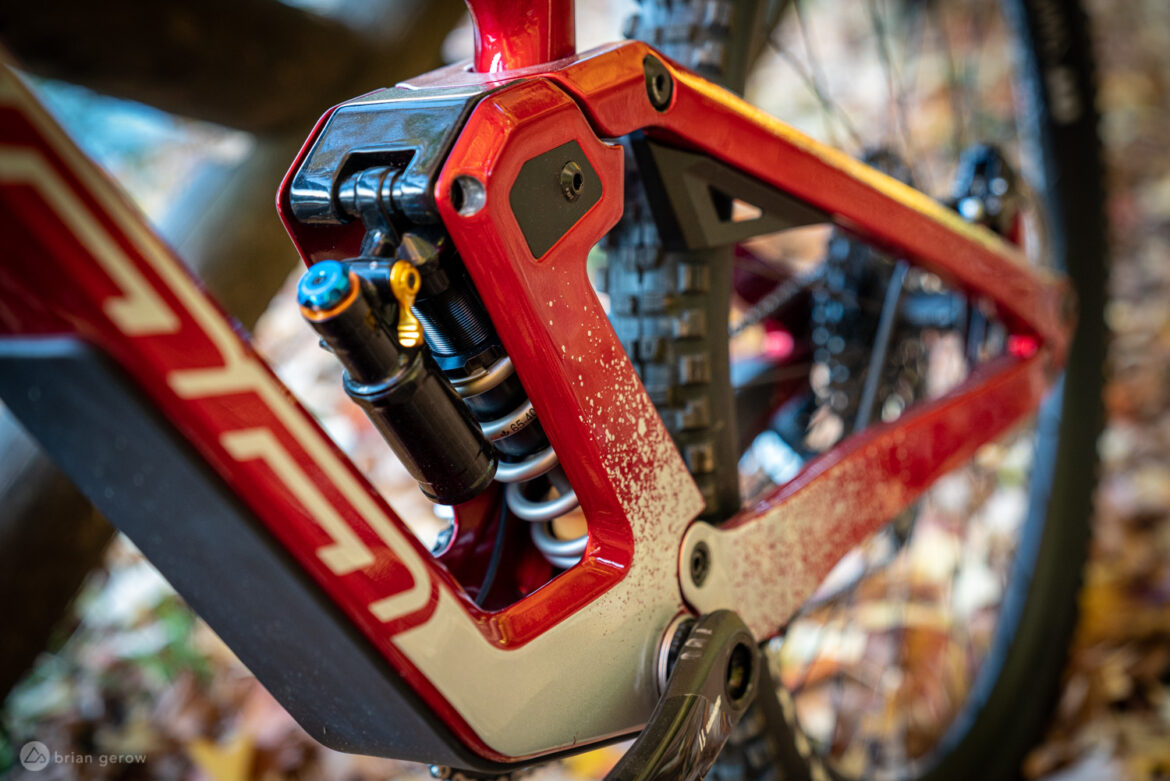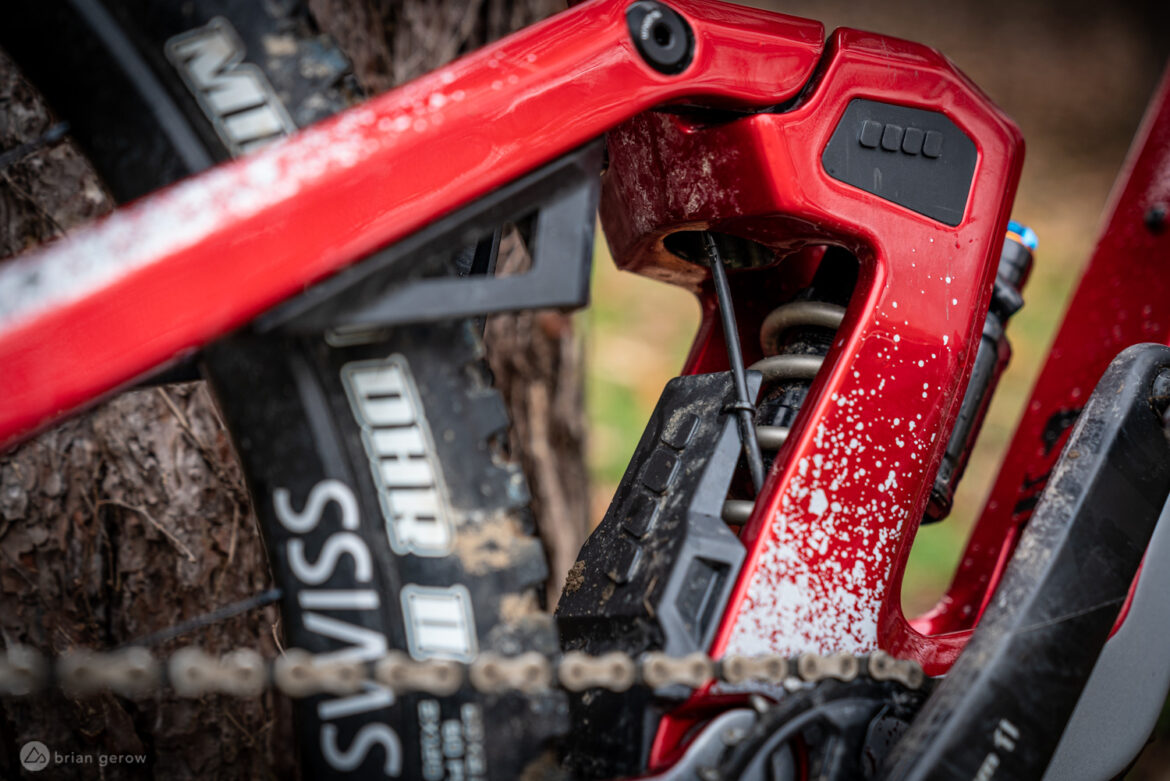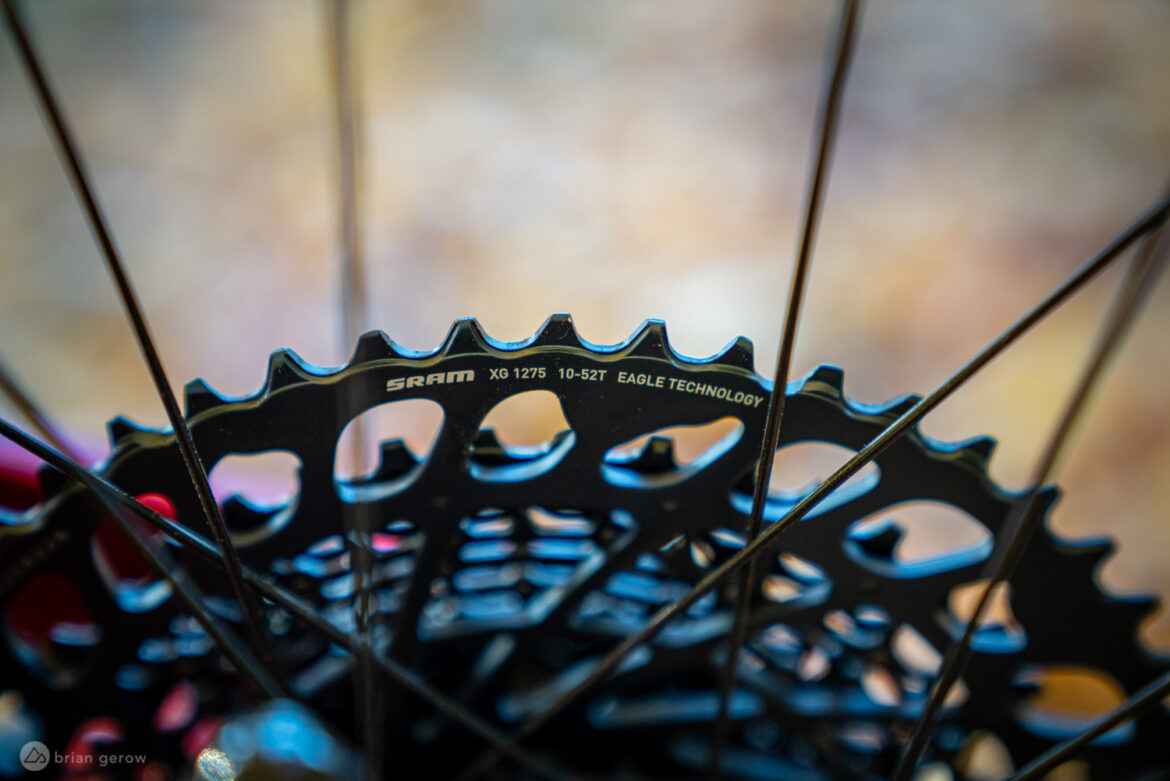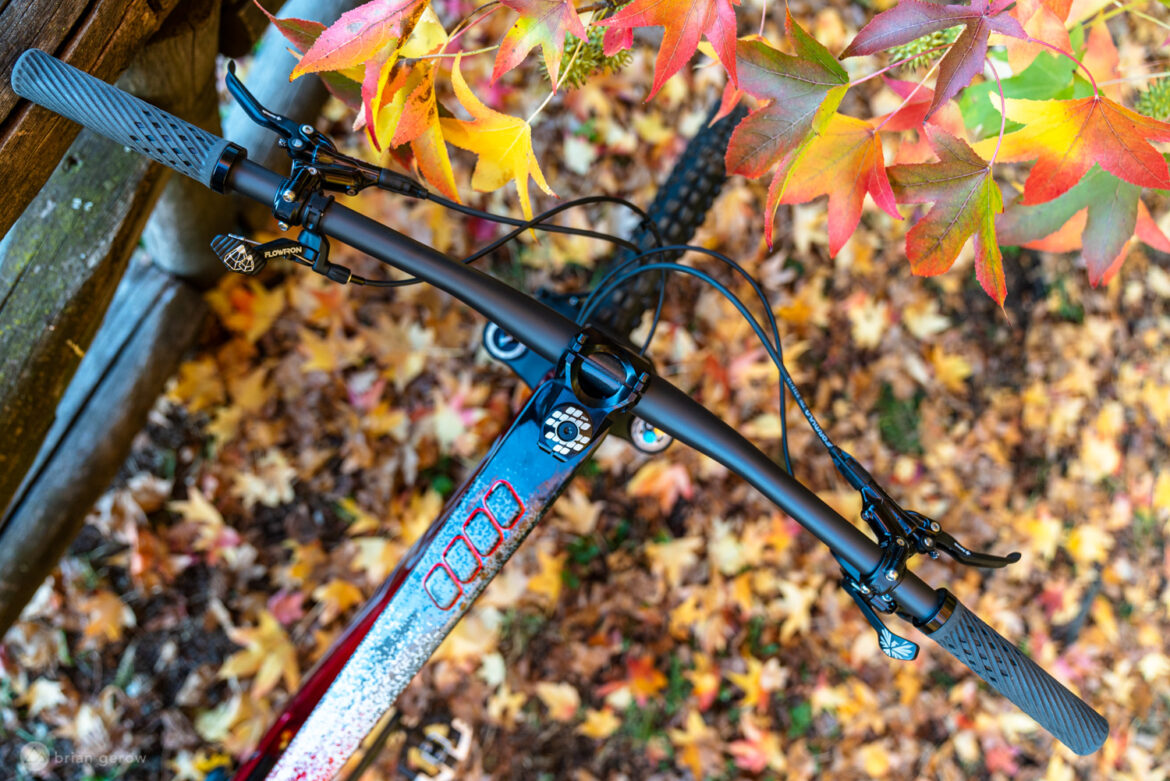
“Who makes that bike?” I’ve heard this query far more times than I expected to while testing the Sunn Kern EN here in Italy. I thought most people knew about this large French bike brand, or would recognize the bike that top-ten ranking EWS riders Kevin Miquel and Theo Galy pilot. Alas, read on and you’ll know loads about this 155/160mm 29er carbon enduro bike.
Sunn has been making BMX bikes since 1982 and kicked off a mountain bike lineup in 1988 with their first rigid steel model. Today they make bikes across several genres of cycling, from gravity MTB to XC, BMX, and aero road machines. The Kern EN is one of their most successful models out on the race track.
Frame features and geometry

There’s no mistaking the Kern EN frame for another. Despite its typical Horst-link suspension design, it has some sharp angles and massive squared-off tubes that make for a unique aesthetic. The gigantic downtube is wider than my hand, making a front fender almost unnecessary. Almost.

The Formula Mod coil shock is hidden in a box of carbon fiber below the seat post, with a fender at the rear to keep some of the trail bits out of the frame. This shock placement makes it virtually impossible to reach the rebound adjustment at the base of the shock, and I was lucky that Sunn had it set close enough to my liking out of the box. While rebound isn’t something folks will adjust on every ride, the fact that you may have to remove the shock from the frame to reach the little red knob is a bummer.

The large well in front of the shock’s base also makes for a voluminous mud catch while riding in wet conditions. The base of the shock, near the bottom-out bumper, is definitely not a place you want to see chunks of mud accumulating. Additionally, the angular rocker linkage creates some pinch points that could cause problems if they fill with trail detritus or mud.
The specific pinch points are demonstrated in the video below. These are precisely the reasons I have deemed this a dry-climate gravity bike. If it’s ridden in the mud regularly it could eat itself over time, and having ridden the Kern EN during two consecutive storms I can confirm that my self-sanding concerns for the frame are valid. While I’m no frame engineer, I asked a friend who is and he shared the same concerns before I could bring them up. All of these concerns, however, are resolved on the aluminum model Kern EN S2 that retails for €2,499.

Internal cable routing on the Kern EN 29er is clean and quiet, and I didn’t experience any issues with cables rubbing or catching on things. With the large slab of protective rubber along the down tube and chain stay, this bike is generally quiet and tidy. There is a pair of plastic thingies on the seat stays that seem intended to wipe excess mud from the tire, though they are so far away from the tread that a sizable mud donut can build up before it touches them. Maybe they are there to keep the Chevrolet Avalanche design theme going?

A size medium frame uses a well-balanced wheelbase between the 439mm chainstays and a 456mm reach measurement that stretches forward through the 65.5° head tube angle for 1220mm total between the axles. The seat tube angle is on the steeper side at 77° to improve the bike’s climbing prowess while remaining short at 435mm to accommodate long dropper posts. None of these numbers are revolutionary or category-leading, but they feel great out on the trail. More on that below.

The Finest build
A build kit called “Finest” seems like it should sit at the top of a bike model lineup, but this one happens to be second in line at €4,999. The Factory build above it retails for €5699, and there’s a Kern S1 carbon frame build below it that sells for €3,599. While those aren’t the most budget-focused build prices, the component spec on these bikes is top notch.
The Sunn Kern EN Finest tested here arrived with the most enduro race-ready build of any bike I have tested thus far. From the trail up, the bike is shod with a pair of Maxxis DHF/DHR II tires with Double Down casing and their stickiest Max Grip tread compound up front. The competition should take note here, as these are the sort of tire casings and compounds that should come on a real gravity bike. Those tires wrap an industry-standard set of DT Swiss EX 1700 Spline wheels, all propelled by a nearly complete SRAM X01 Eagle drivetrain mixed with an XG 10-52t cassette.
The drivetrain and wheel set worked flawlessly on this bike, and both seemed well suited to its lengthy descending and climbing intentions. I have ridden these DT Swiss wheels on multiple bikes now, and I haven’t once had an issue with them. While there could be small improvements in their freehub engagement, they don’t pop or clack in the corners, and the bearings roll nice and smooth through the muddy months.
Some amount of head-scratching was necessary concerning the 10-52t cassette. The trails that I climb are indisputably steep, and that pie-plate of a cog seemed like it would make them more manageable. Instead, I felt like it just made me climb considerably slower, as evidenced by the fact that I got passed by far more riders than I ever do on our local climbs. “Is that an e-bike? Nope, I’m just going slow.” The 52t is too spiny and slow to be useful. Additionally, the jump between the second-lowest 42t cog and that 52t feels dramatic. It’s like shifting from a comfortable cadence to a hamster spin that’s so slow it’s hard for my silly brain to maintain balance. While this hubcap-size cog will have some riders smiling, I’ll stick with a smaller 46 to 50t low gear.

Squishing and stopping are both handled by Formula, with a powerful set of the Cura 4 brakes, a 160mm Selva C fork, and their new Mod coil shock. The suspension functioned fantastically, and you can read my reviews of those components separately if you like. The simple Selva C and hyper-adjustable coil are well-suited to this build, despite the fact that the frame prevents rebound clicking.
I did have an issue with the rear brake at the tail end of the test. I was on the descent portion of a lunch lap, setting up for a sharp and steep turn when the rear brake pulled all the way to the bar with no bite. I had to grab the front lever and catapult myself into a thicket of blackberry bushes. Thankfully, I was wearing some tough pants and a rain jacket. I went home and bled the brake to Formula’s exact spec, only to find the same result on the next ride. Sunn offered to send me a new brake the following day, stating their concern as they hadn’t seen this sort of issue with that brake before. Nor have I. The other Cura 4 brakes I have used in the past worked without issue. I may have bled them incorrectly, despite following the directions, but that wouldn’t explain the initial failure. Having bled them multiple times before on my own bikes, I think there is something more to the story.
I want to add that I have seen a notable rise in issues with bike components this season, possibly linked to the giant wave of bike buying and unprecedented production increase across the industry. Those annual issues included warranties of two other brakes from different brands. We’re all adjusting to the rising demand and there will be some hiccups here and there.
Trail party time
Do you primarily ride in a dry climate and want to enjoy a plucky 29er? Maybe pick up a Kern EN and just go smile your way through the forest because this thing is a blast to ride on any trail. If you’re wondering why I mention the dry climate, check paragraph three of the frame and geo details above, or skip ahead and just buy the alloy version.
In my mind, a great enduro bike is one that’s fun to ride everywhere and shines on rough descents. In that same brain, a coil-sprung 29er is not necessarily going to be the most exuberant bike. Sunn has managed to combine all of the necessary go-fast enduro qualities in this bike with a rollicking platform that’s capable of a lot more than plowing straight lines. A piece of that play-factor is due to the bike’s somewhat lighter 14.8kg (32.6lbs) weight (with gravity tire casings), but the rest is pure suspension and geometric magic. Or science. Probably it’s science.
Riding the Kern EN 29er feels akin to playing with a happy puppy when it’s just reached maximum body growth. It’s keen to bound around and not afraid to be tossed about where the older dogs might get grumpy. It snaps out of corners with a grip character that invites faster exits, while the rear end snaps back with every bit of energy that a rider can put in. For riders who prefer to pop from rock to root, rather than dozing through them for speed, this may be your 29er. Miquel and Galy are fast on the tighter European EWS tracks, and this bike could be part of their success stories.

We’re relegated to the trails within our city of residence here in Italy, which cuts my longest descents on this bike to roughly six minutes. Having tested the Formula Mod on near twenty-minute-long tracks, I know that the bike will feel the same on high alpine adventures with four times as much elevation loss. When the trail opens up enough that you can let go of the brakes until the speed becomes scary, the Kern EN holds a fairly confident line. It’s not the most comfortable bike at top speed, but it feels a lot better than some bikes with similarly boundful party ethics. The mid-length 439mm chain stays are long enough to give the rider a sturdy “between the wheels” feeling when the suspension is compressed with successive fast impacts, despite the bike’s average BB drop of 25mm.
When it comes time to put power into the Kern EN 29, riders will find a solid platform. The robust carbon frame feels notably stiff, with very little flex during full-on pinned sprints. Any time you need to get up and give it, this bike will be there to support your efforts. On climbs and transitions, pilots will want to flip the Mod climb switch to firm up the shock, as there is some pedal-bob that’s noticeable while spinning up the road or trail. That’s the price we pay for fantastic small bump compliance and trail-smoothing coil performance. Should you forget to flip the switch before descending, the Mod shock will still open up on large impacts, allowing you to complete the run — free of excuses.
Coming from the industry-leading 80° seat tube of the Privateer 161 this bike’s seat tube felt a touch slack on the first climb, but after sliding the saddle forward I was able to achieve a similar saddle position that made the long legged 29er a pleasure to climb with.
While I’m no trickster on the bike, the Kern EN platform has been fun to jump and manual to the best of my meager abilities. It’s easy to get the front tire off the ground and hold it for a bit, and I have felt comfortable hitting larger jumps on this bike than most others.
Who’s the Kern EN designed for?

The Kern EN is on the shorter side of an enduro bike travel scale, and you can bet that will soon change. Given the unique frame characteristics, this is a bike for the enduro racer or trail rider who pedals in the sun most of the year and loves to dance with their bike as much as they enjoy its speed. There’s the added benefit that you will often be the only person on the trail with a whip that looks like yours, which is important for some folks.
























0 Comments